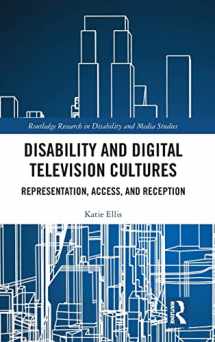
Disability and Digital Television Cultures: Representation, Access, and Reception (Routledge Research in Disability and Media Studies)
ISBN-13:
9781138800069
ISBN-10:
1138800066
Edition:
1
Author:
Katie Ellis
Publication date:
2019
Publisher:
Routledge
Format:
Hardcover
204 pages
FREE US shipping
Book details
ISBN-13:
9781138800069
ISBN-10:
1138800066
Edition:
1
Author:
Katie Ellis
Publication date:
2019
Publisher:
Routledge
Format:
Hardcover
204 pages
Summary
Disability and Digital Television Cultures: Representation, Access, and Reception (Routledge Research in Disability and Media Studies) (ISBN-13: 9781138800069 and ISBN-10: 1138800066), written by authors
Katie Ellis, was published by Routledge in 2019.
With an overall rating of 4.5 stars, it's a notable title among other
books. You can easily purchase or rent Disability and Digital Television Cultures: Representation, Access, and Reception (Routledge Research in Disability and Media Studies) (Hardcover) from BooksRun,
along with many other new and used
books
and textbooks.
And, if you're looking to sell your copy, our current buyback offer is $0.33.
Description
Disability and Digital Television Cultures offers an important addition to scholarly studies at the intersection of disability and media, examining disability in the context of digital television access, representation and reception. Television, as a central medium of communication, has marginalized people with disability through both representation on screen and the lack of accessibility to this medium. With accessibility options becoming available as television is switched to digital transmissions, audience research into television representations must include a corresponding consideration of access. This book provides a comprehensive and critical study of the way people with disability access and watch digital TV. International case studies and media reports are complimented by findings of a user-focused study into accessibility and representation captured during the Australian digital television switchover in 2013-2014. This book will provide a reliable, independent guide to fundamental shifts in media access while also offering insight from the disability community. It will be essential reading for researchers working on disability and media, as well as television, communications and culture; upper-level undergraduate and postgraduate students in cultural studies; along with general readers with an interest in disability and digital culture.


We would LOVE it if you could help us and other readers by reviewing the book
Book review

Congratulations! We have received your book review.
{user}
{createdAt}
by {truncated_author}


